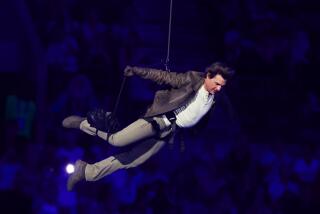Poetic Piano and Visuals Send âPlanetsâ Program Into Orbit
The Pacific Symphony concert Saturday at Verizon Wireless Amphitheater was called âThe Planetsâ after the Holst score that dominated the second half of the program. But the program really was about space and time.
Space because âThe Planetsâ was accompanied by a Mark Hatch Productions film incorporating NASA images and computer graphics; time in the poetic playing of Van Cliburn silver medalist Antonio Pompa-Baldi in Griegâs Concerto in A minor.
Pompa-Baldi knew how to suspend time, letting a phrase hover and expand in poised inner stillness.
The 26-year-old pianist relied on warmth, exquisite taste and unassertive but arresting technique to make the case for Grieg and, incidentally, to justify his high standing in the recent Cliburn competition.
His collaboration with conductor Carl St.Clair was particularly sympathetic and tight. He played Moszkowskiâs Etude in F, Opus 72, No. 6 as his single encore.
Reactions to the music-film version of âThe Planetsâ came in stages. First, a dislocation set in. Holst was thinking in astrological terms (âMars, the Bringer of Warâ; âVenus, the Bringer of Peaceâ). NASA had reality on its mind.
Once past its cloud cover, Venus was just another hot rock, not an erotic influence.
Yet, the visuals soon generated their own mythos and magic, particularly when the filmmakerâs imagination flew freely in âJupiter, the Bringer of Jollity.â
St.Clairâs efforts at first faded into the background (the visual dominates the aural), but he led a magisterial performance.
The program ended in a rousing blaze of fireworks accompanying John Williamsâ title music from âStar Wars.â
More to Read
The biggest entertainment stories
Get our big stories about Hollywood, film, television, music, arts, culture and more right in your inbox as soon as they publish.
You may occasionally receive promotional content from the Los Angeles Times.










